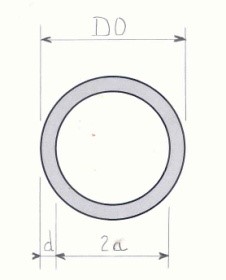Modeling the acoustic behavior of curved absorbers is of the greatest interest in terms of acoustics.
Indeed, curved absorbers occupy a place of choice among the soundproofing components since they constitute the lining of the cylindrical dissipative silencers, often used in the context of industrial sound insulation projects (e.g. for fan discharge, downstream of the diffusers of vent silencers for pressurized gas, downstream of reactive mufflers for thermal engine exhaust lines) and for noise reduction of air-conditioning installations in buildings (e.g. with spiral metal ducting networks).
The performance of noise reduction devices incorporating curved absorbers may, in the absence of an accurate evaluation of their acoustic behavior, and in a number of cases, be extrapolated from that of planar absorbers, which then avoids tedious calculations.
But in other cases, this approach does not allow a sufficient accuracy for the results of simulation of acoustic performance of silencers.
The acoustic behavior of a curved layer of absorber (e.g. mineral wool, foam) must then be evaluated taking into account its geometrical specificity, which often requires the use of means of calculations out of norms, because having to be sufficiently powerful to allow the processing of a large number of operations in connection with the use of atypical functions with complex argument, and thus with conditions of use not always very accessible to the ordinary human resources of acoustical engineering offices and not always proportionate: neither with respect to the financial area of the projects in which an acoustic simulation is required, nor with respect to the time allowed to carry out the studies in question (not all those who want to, have the means of a company manufacturing aircrafts, rockets or submarines ...).
Namely in relation to the sizing of silencers, ITS has integrated the modeling of the acoustic behavior of curved absorbers with the software SILDIS®, easy to use since in Excel format, by allowing the calculation of the impedance of a non-plane absorbing layer, of any thickness and with a filling can be chosen freely provided that the characteristics such as resistivity, porosity (at least) are known (and then available in one of the libraries of the software).
Specific computational routines have been developed, involving the evaluation of Bessel and Neumann functions with complex argument by simplified methods integrated in Module 1 of the acoustics calculation software SILDIS®.
The expected consequence of the implementation of these new functionalities in the SILDIS® software (for modeling the acoustic behavior of curved absorbers) is the ability to refine the performance prediction of silencers with a circular cross-section, for example for the design of silencers for industrial applications or for aeraulic installations:
- either with Module 1 of the SILDIS® software
- or with other simulation tools when they do not have a calculation stage as sophisticated as SILDIS® for taking curved absorbers into account: the impedance or admittance data of curved absorbers can be exported from the SILDIS® software with a format compatible with some calculation tools available on the market e.g. FEM, BEM
With regard to cylindrical silencers with peripheral absorbing lining locally reacting (without central pod) e.g. such as can be installed inside an industrial stack, of which the duct is then used as an envelope for the silencing device, to limit its sound power at outlet, the comparison of simulation results with bibliographic data (results measurements, calculation results by others, ...) has shown, for many combinations of parameters inflencing the sizing (not only the length and the transverse dimensions d and 2a on sketch below for mounting C0A), an agreement which has been considered sufficient to allow the validation of this new acoustical calculation capacity now available at ITS: cf. Terminal 3 of software SILDIS® Module 1.
|
Cylindrical silencer with peripheral absorbing lining with thickness d and with inner diameter 2a |
